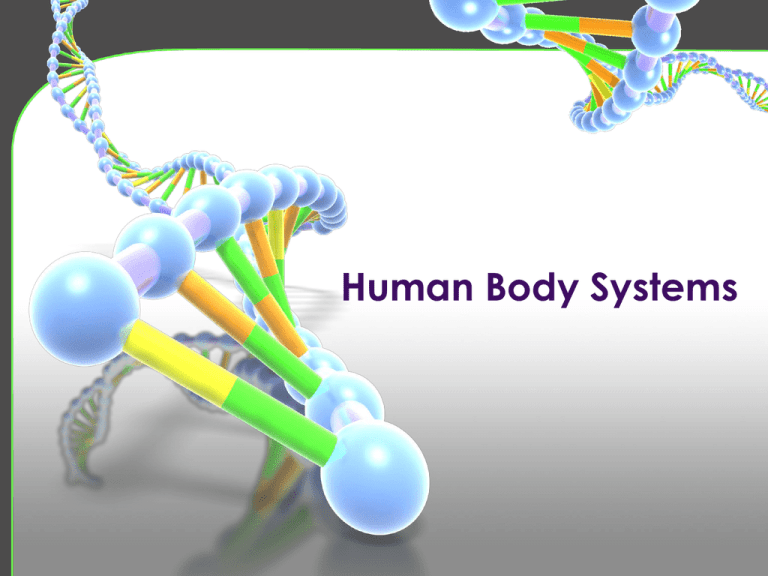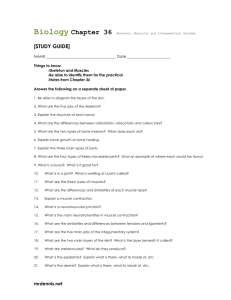Human Body Systems
advertisement

Human Body Systems •What Makes a Body? • • • • Cells- smallest living part of the body Tissues- 2 or more similar cells Organs- 2 or more similar tissues Body Systems- 2 or more organs 2. 5. 4. 3. 6. 1. 7. •REVIEW • Tissues Cells make ________________. Tissues Organs • _______________ make ___________________. • ______________ make _____________________. Organs Body Systems •4 Main Types of Tissue • Epithelial- covers and protects (skin) • Nervous- sends electrical signals • Muscle- produce movement • Connective- joins, supports, protects, insulates, nourishes, and cushions organs •Skeletal System • Function: • • • • • • • • Support Protect Movement Components Bone Cartilage Ligament Joint •What’s In A Bone? • 2 Types of Bone Tissue: • • Compact Bone- no open spaces. • Gives bone strength; calcium deposited. • Blood vessels located here • Located in long parts of bone Spongy Bone- open spaces. • • Located on ends of bone Bone Marrow • Red Marrow- produces Red Blood Cells (RBC) • Yellow Marrow- Stores fat •Growing Bones! Most bones start soft, rubbery, and flexible. This is cartilage! • Located on ends of bones. • Do not have blood vessels. • What’s the Point of a Joint? • Joint- a place where 2 bones meet. • Allow your body to move when muscles bend • Some allow for a lot of movement • Some allow for a little or no movement Ligament vs. Tendon • • Ligament- bone to bone Tendon- muscle to bone Skeletal System Muscular System • Function: • • • Movement Over 600 Muscles! Muscles can be grouped into 2 categories: • • Voluntary- you can control Involuntary- you cannot control Muscular System 3 Types of Muscle • Smooth • • Involuntary Internal organs • Skeletal • Muscle tissue attached to bone • Cardiac • Heart only Muscles Work In Pairs! • • Contracting & Extending Contract- shortening Extend- lengthening If a muscle bends part of your body, then that muscle is called a flexor. If the muscle straightens part of your body, then it is BICEP called an extensor. BICEP TRICEP TRICEP Use It or Lose It! Muscles that are given regular exercise cause an increase in muscle cells! Muscles that aren’t given regular exercise cause an decrease in muscle cells! •Cardiovascular System • • • • • Function-transport nutrients, gases, hormones, and waste. Components Blood Blood Vessels- arteries, veins, capillaries Heart What is Blood? Blood Blood Cells Plasma (45%) (55%) Red Blood Cells White Blood Cells Red Blood Cells vs. White Blood Cells RBC • • • Large quantities Made in bone marrow Contains hemoglobin • Red color • Allows oxygen to bind ** Platelets Tiny particles that help clot blood. WBC • • • Keep you healthy Destroy pathogens • Bacteria or virus Made in bone marrow • • • • • 4 Chambers About the size of fist Upper Chambers- Atrium Lower Chambers- Ventricle 4 Valves that prevent blood from flowing back Heart Video Your Heart Blood Vessels • Artery- blood AWAY from heart. • • Vein- blood TO heart • • Oxygen rich Oxygen poor Capillary- connects artery to vein • Thin walls allow for exchange Vein or Artery? Vein or Artery? Under Pressure • Force exerted on the wallsBLOOD PRESSURE Diastolic Pressure: Pressure in arteries when ventricles relax. Systolic Pressure: pressure in artery when ventricles contract. 120 80 Respiratory System Provides cells with oxygen and removes carbon dioxide Lungs-sponge-like. Bronchioles have thousands of tiny sacs called alveoli. Pharynx-throat. Branches into 2 passages (larynx and esophagus) Larynx-voice box. Trachea-windpipe. Bronchi-two tubes that go to each lung. Each tube branches into thousands of BRONCHIOLES. Pharynx Out With the Bad Air; In With the Good • Respiration- entire process by which a body obtains and uses oxygen and gets rid of carbon dioxide and water. • Two parts: • Breathing- involves inhaling and exhaling. • Cellular Respiration- reactions that release energy from food. Alveoli Exchange Respiratory System • Oxygen passes into capillaries • Carbon passes from capillaries into alveoli How Do You Breath? Nervous System • • • Function- send and receive messages Two Parts Central Nervous• • Brain & Spinal Cord Peripheral Nervous• Nerves Neurons are made of: • Cell Body • Dendrites- receive messages from other neurons and send to cell body. • Axons- carry messages away from cell body. Neuron- transfer messages. The Brain • 3 parts • • • Cerebrum- largest • Memory • Personality Cerebellum• Controls muscles • Balance Brain Stem• Controls functions of organs Two Hemispheres: Right Hemisphere controls left side of your body. -Controls activities involving imagination and creativity. Left Hemisphere controls right side of your body. - Controls speaking, reading, writing, and solving problems. •Nervous System Nervous System Simplified Nervous System Peripheral Nervous System Autonomic NS Central Nervous System Somatic NS Brain Spinal Cord Endocrine System • • • Control body activities by producing hormones. Hormoneschemicals made by glands. Gland- group of cells or organ that secrete hormone. Glands at Work Pituitary Gland: secretes hormones that affect other glands and organs. Called the “Master Gland”. Thyroid Gland: regulates metabolism (or how fast you burn food). Parathyroid Gland: regulates calcium levels. Glands at Work Adrenal Gland: helps body respond to stress/danger. Releases adrenaline. Pancreas: regulates sugar (insulin) levels and digestive enzymes. -Diabetes Type 1- produces little or no insulin. Thymus Gland: produce infection fighting cells. Components • Mouth • Esophagus • Stomach • Small Intestine • Large Intestine • Rectum • Anus Digestive System Digestive System Break down food and remove solid waste. Breaking It Down • • Digestion- break down of food. • Mechanical Digestion- chewed, mixed, churned • Chemical Digestion- chemicals break down large molecules Enzymes- special substance breaks down nutrients Organs Digestive Tract Organs: Mouth Esophagus Stomach Small Intestines Large Intestines Rectum Anus Accessory Organs: Tongue Teeth Salivary Glands Liver Gallbladder Pancreas •Urinary System • • • • • • Function- remove liquid waste Components Kidneys Ureters Bladder Urethra







